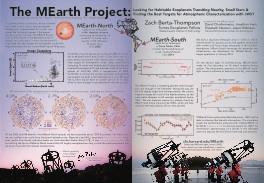The MEarth Project

|
What are exoplanets? |

|
An extrasolar planet, or "exoplanet", is any planet that orbits a star other than the Sun. We know of exoplanets of all sizes, from bigger than Jupiter to smaller than Earth. Just like in our Solar System, exoplanets can orbit their stars at any distance; some exoplanets orbit so close to their stars that their surface temperatures are hot enough to melt iron! Some exoplanets will orbit at just the right distance that we say they're in their star's "habitable zone", that they are the right temperature to have liquid water at their surface and might be able to support life. |
|

|
How do we find them? |
|
Exoplanets are difficult to see directly from Earth. Because they are so small and faint, they are easily lost in the glare of the bright stars they orbit, so we often use indirect methods to find them. One of these is called the "transit method", where we carefully measure the brightness of a star over a long period of time, and look for periodic decreases in the brightness of a star that are caused by a planet passing in front of it. The MEarth Project uses the transit method to look for planets. |
|
Why M dwarfs? |

|
|
Stars come in all sizes. Most of the stars in the Galaxy are stars much smaller than the Sun, stars that astronomers call "M dwarfs." If we're looking for planets by measuring how much of their stars' light they block, then small stars like M dwarfs are great places to look: the same size planet will block a larger fraction of the light from an M dwarf than it would of a larger star like the Sun. M dwarfs are also much cooler in temperature than the Sun, so a planet with the right temperature for life will orbit an M dwarf more closely and be more likely to pass in front of it, as seen from our telescopes. So, by focusing our efforts on M dwarf stars, we improve our chances of finding Earth-like planets - that's how we got our name, the MEarth Project! |
|
What's next? |
|

|
After we find an exoplanet with MEarth, how can we learn more about it? One kind of observation we can make is called "transmission spectroscopy." When a planet passes in front of its star, a tiny fraction of the star's light passes through the planet's atmosphere before reaching us. By very carefully measuring the color of this light (which we call the transmission spectrum), we can learn about what molecules make up the planet's atmosphere. When we make these measurements, it's like we're watching sunset on a different planet! If we find a potentially habitable planet with MEarth, the next generation of big telescopes like the 6.5 meter James Webb Space Telescope or the 24.5 meter Giant Magellan Telescope will help us study the composition of its atmosphere. But we have to find the planet first! |
|
Read more! |
|
|
Click the image at right to find more about the science involved in the MEarth Project. This is a copy of a recent MEarth poster presented at the May 2014 conference on "Habitable Worlds Across Space and Time" at the Space Telescope Science Institute in Baltimore, MD. Also, you can read more about MEarth's discoveries and publications here. |

|

This website is maintained by members of the MEarth Project. Please feel free to contact us with any comments or questions.
